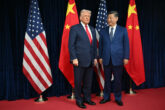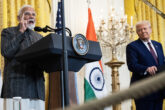March 31, 2021
Positive Visions, Powerful Partnerships
The Keys to Competing with China in a Post-Pandemic Indo-Pacific
Executive Summary
The United States was losing ground to China in the Indo-Pacific when the COVID-19 crisis began. China’s growing economic might, military modernization, and aggressive diplomatic efforts were already eroding America’s competitive advantage and shifting the regional balance of power. A year after the virus first spread, it is possible to identify where the pandemic is affecting diplomatic, economic, and defense trends in ways that could accelerate declines for the United States, but also might create opportunities to reverse or mitigate some of them.
Restoring U.S. alliances and partnerships in the Indo-Pacific is critical to competing effectively against China, and President Joe Biden has made this a top foreign policy priority. In particular, his administration is making the Quadrilateral Security Dialogue—a strategic forum commonly known as the Quad, which is comprised of the United States, Japan, Australia, and India—a core component of its approach to the Indo-Pacific. Chinese post-outbreak behavior has driven increased cooperation among these four countries in the diplomatic, economic, and defense domains to address shared challenges from China. Seizing the opportunities this cooperation creates is critical for the United States.
While expanding U.S. cooperation with Quad countries, the United States cannot neglect Southeast Asia, where competition with China for influence is fiercest. Southeast Asia is at the heart of U.S. and Japanese efforts to promote a free and open Indo-Pacific, and is a region where Australia has played a traditional leadership role. Competing effectively with China requires offering Southeast Asian countries a positive alternative vision to the one Beijing promotes. Whether the United States and its fellow Quad democracies can help Southeast Asian countries recover from the COVID-19 crisis will be a key litmus test of their ability to deliver on such an agenda.
This report offers recommendations for the United States to take unilaterally and in close cooperation—bilaterally, trilaterally, and through the Quad—with Japan, Australia, and India to address challenges and seize opportunities created by the COVID-19 crisis along three lines of effort: diplomatic, economic, and defense.
Diplomatic Lines of Effort
- Swiftly follow through with plans to work with Japan and Australia to fund the Indian production of at least one billion vaccine doses and their distribution in the Indo-Pacific. Consider additional vaccine diplomacy options to pursue unilaterally or in concert with the Quad and other countries.
- Option 1: Lay the groundwork for an eventual smooth transition from distributing vaccines in the United States to distributing them abroad.
- Option 2: Provide financial support to fund the purchase and distribution of vaccines in the Indo-Pacific, especially among Southeast Asian countries.
- Option 3: Consider additional steps to boost vaccine production by supporting distributed manufacturing capacity in the Indo-Pacific.
- Option 4: Create an Indo-Pacific COVID-19 response mechanism that includes Quad and Association of Southeast Asian Nations (ASEAN) countries, South Korea, Taiwan, New Zealand, and the Pacific Islands.
- Build shared mechanisms for tackling Chinese disinformation about the origins of COVID-19 and the efficacy of Western vaccines.
- Prioritize public health and emergency preparedness in Quad and ASEAN engagements, and increase public health assistance to Southeast Asian countries.
Economic Lines of Effort
- Prioritize helping Indo-Pacific countries, especially those in Southeast Asia, deal with debt problems resulting from or exacerbated by the COVID-19 crisis.
- Accelerate implementation of existing assistance programs for infrastructure and human capital development in the region and enhance coordination with other Quad countries on the delivery of assistance.
- Pursue small-scale trade initiatives, while simultaneously exploring the costs and benefits of entering the Comprehensive and Progressive Agreement for Trans-Pacific Partnership.
- Balance reshoring with diversification of supply chains and emphasize efforts to help allies and partners deepen their own supply chains.
- Expand opportunities for Quad engagement on economic issues in the Indo-Pacific.
Defense Lines of Effort
- Increase defense integration with Japan and Australia.
- Adapt exercises to account for potential reductions in presence and possible future disruptions to training cycles.
- Seize opportunities to expand the U.S.-India defense relationship.
- Seek opportunities to reinforce and expand defense ties between all four Quad countries
Download the full report.
More from CNAS
-
Indo-Pacific Security / Energy, Economics & Security
How to Win the Economic War with ChinaTrump's approach to China has run aground, giving Beijing unprecedented advantage in the economic conflict....
By Edward Fishman & Julian Gewirtz
-
America’s Self-Loathing Is a Losing Hand
This article was originally published in The Washington Post.Around 10 years ago, the United States began a historic shift in its grand strategy toward China, abandoning the b...
By David Feith
-
Indo-Pacific Security / Energy, Economics & Security / Technology & National Security
Selling AI Chips Won’t Keep China Hooked on U.S. TechnologyU.S. policy should not rest on the illusion that selling chips can trap China inside the American tech ecosystem....
By Janet Egan
-
Will New Delhi-Beijing Move Beyond Friction Points? | Ex-White Official On India-China Reset
Prime Minister Narendra Modi on Friday said that India and China, as two major economies, must work together to bring stability to the global economic order. NDTV's Gaurie Dwi...
By Lisa Curtis








